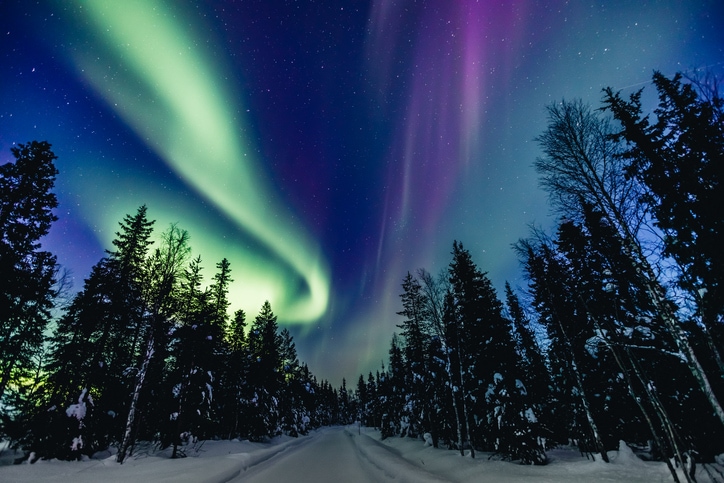What Causes the Colours in Aurora Borealis?
Few natural phenomena captivate the human imagination quite like the Aurora Borealis, also known as the Northern Lights. This dazzling display of light in the night sky has fascinated people for centuries, and its vibrant colours are a source of endless wonder. But what exactly causes these colours? In this blog post, we will delve into the science behind the Aurora Borealis, the role of Earth’s magnetic field, why auroras come in different colours, the best places to see them, and historical interpretations of this mesmerising phenomenon.
The Science Behind Aurora Borealis
The Aurora Borealis is a result of interactions between solar wind and the Earth’s atmosphere. Solar wind is a stream of charged particles released from the sun’s upper atmosphere, known as the corona. When these particles reach Earth, they collide with gases in our atmosphere, such as oxygen and nitrogen. These collisions excite the gas particles, causing them to emit light. This process is similar to how neon lights work.
The light emitted during these collisions is what we see as the Aurora Borealis. The phenomenon typically occurs in the polar regions because the Earth’s magnetic field directs the solar wind particles towards the poles. The result is a stunning display of lights that can range from subtle glows to dramatic, dancing patterns in the sky.
The Role of Earth’s Magnetic Field
Earth’s magnetic field plays a crucial role in the formation of the Aurora Borealis. The magnetic field acts as a shield, protecting us from the harmful effects of solar wind. However, it also channels these charged particles towards the polar regions, where they interact with the atmosphere to create auroras.
The magnetic field lines converge at the poles, creating what is known as the auroral oval. This oval is where auroras are most likely to be seen. The intensity and frequency of auroras can vary depending on the level of solar activity. During periods of high solar activity, known as solar storms, the auroral oval can expand, making auroras visible at lower latitudes.
Why Do Auroras Come in Different Colours?
The colours of the Aurora Borealis are determined by the type of gas particles involved in the collisions and the altitude at which these collisions occur. Oxygen and nitrogen are the primary gases responsible for the different colours seen in auroras.
- Green: The most common colour, green, is produced by oxygen molecules located about 60 miles above the Earth.
- Red: Red auroras are also caused by oxygen, but at higher altitudes, around 200 miles above the Earth.
- Blue and Purple: These colours are produced by nitrogen molecules. Blue appears at lower altitudes, while purple and violet hues are seen at higher altitudes.
The varying energy levels of the solar wind particles and the type of gas they collide with result in the different colours and patterns observed in the auroras.
The Best Places to See Auroras
For those eager to witness the Aurora Borealis, Finnish Lapland is one of the best places in the world to do so. The region lies within the auroral oval, providing optimal conditions for aurora sightings. The probability of seeing auroras in Lapland is approximately 50% on any given night during the aurora season, which spans from late August to April.
Some of the top locations in Finnish Lapland for aurora viewing include:
- Saariselkä: Known for its clear skies and minimal light pollution, making it an ideal spot for aurora hunting. This is where our villas are located and we can guide you to see the beautiful lights!
- Levi: A popular ski resort with excellent facilities for winter activities and aurora viewing.
- Ylläs: Offers a range of outdoor activities and stunning landscapes, perfect for a memorable aurora experience.
For the best experience, consider joining a guided tour. Expert guides can take you to the best viewing spots and provide valuable insights into the science and folklore of the Northern Lights.
Historical Interpretations of Auroras
Throughout history, the Aurora Borealis has been the subject of various myths and legends. Different cultures have their own interpretations of this celestial phenomenon.
In Finnish folklore, the Northern Lights were believed to be caused by a magical fox running across the Arctic tundra, sweeping its tail and sending sparks into the sky. This is why the auroras are sometimes referred to as “revontulet,” which translates to “fox fires” in Finnish.
In Norse mythology, the auroras were thought to be the reflections of the Valkyries’ armour as they led fallen warriors to Valhalla. Indigenous peoples in North America also have rich traditions and stories explaining the Northern Lights, often viewing them as spirits or ancestors dancing in the sky.
These historical interpretations add a layer of cultural richness to the scientific understanding of the Aurora Borealis, making the experience of witnessing them even more magical.
At VALO Finland, we aim to provide our guests with an unforgettable experience in the heart of Finnish Lapland. Our luxury villas offer the perfect setting to witness the Aurora Borealis in comfort and style. Whether you’re relaxing by the fire or enjoying a sauna, you can marvel at the Northern Lights through large picture windows, making your stay truly special. For those looking to explore further, we can help organise guided tours and other activities to ensure you make the most of your time in this enchanting region.
In conclusion, the Aurora Borealis is a breathtaking natural phenomenon that combines the beauty of science and the allure of folklore. By understanding the causes behind its vibrant colours and knowing the best places to see it, you can fully appreciate this awe-inspiring spectacle. We invite you to experience the magic of the Northern Lights with us at VALO Finland, where adventure and luxury await.
